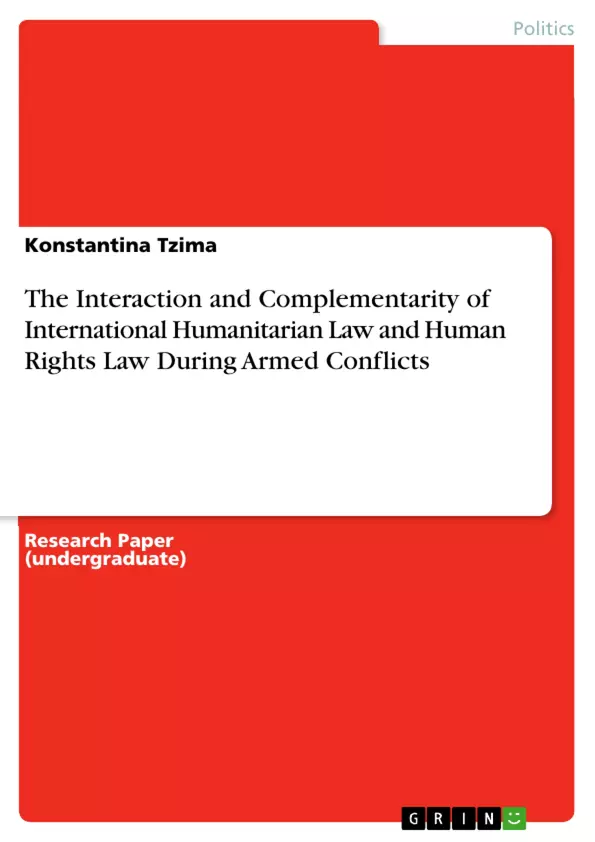The current landscape of global conflicts demands an urgent need to protect populations from severe violations of fundamental rights. This paper explores the intersection of International Humanitarian Law (IHL) and Human Rights Law (HRL) in addressing such challenges. Traditionally, IHL was applied during war, while HRL was seen as relevant only in peacetime. However, modern perspectives recognize the complementary and mutually supportive roles of these legal systems. By examining their interaction, this study highlights the potential for enhanced protection during armed conflicts, despite practical issues such as extraterritoriality and proportionality in the use of force. This analysis contributes to the broader effort of resolving conflicts and safeguarding human rights.
Inhaltsverzeichnis (Table of Contents)
- Introductory Note.
- 1. The interaction between Human Rights Law and International Humanitarian Law during armed conflicts
- A. The sources and principles of law of each legal system
- 1. The simultaneous application of Human Rights Law and International Humanitarian Law to armed conflicts
- (a) Human rights protection in non-international armed conflicts and the protection of victims
- 2. The problems arising from the application of the Human Rights Law and International Humanitarian Law in armed conflicts
- B. Extraterritorial application of Human Rights Protection
- 2. Proportionality in relation to the use of force
- (a) The United Nations framework regarding human rights protection during armed conflicts
- Conclusions
- Bibliography
Zielsetzung und Themenschwerpunkte (Objectives and Key Themes)
This study examines the interaction between International Humanitarian Law (IHL) and Human Rights Law (HRL) in the context of armed conflicts, highlighting the challenges and opportunities of applying both legal systems simultaneously. It aims to explore how these legal frameworks contribute to resolving armed conflicts and protecting victims of human rights violations.
- The sources and principles of law governing IHL and HRL
- The simultaneous application of IHL and HRL in armed conflicts
- The extraterritorial application of human rights protection
- Proportionality in the use of force
- The role of the United Nations in protecting human rights during armed conflicts
Zusammenfassung der Kapitel (Chapter Summaries)
- Chapter 1:
- The chapter begins by outlining the sources and principles of law that underpin IHL and HRL, highlighting their distinct origins and historical development.
- It analyzes the concurrent application of both legal systems in armed conflicts, emphasizing their complementary nature and potential challenges in implementation.
- The chapter focuses on the protection of victims in non-international armed conflicts, discussing the unique challenges of safeguarding human rights in such contexts.
- Chapter 2:
- This chapter delves into the complexities of applying IHL and HRL simultaneously in armed conflicts, acknowledging the various hindrances that can arise.
- It examines the concept of extraterritorial application of human rights protection, exploring how state jurisdiction can extend beyond national borders to safeguard human rights in international contexts.
- The chapter then analyzes the principle of proportionality in relation to the use of force, focusing on its application in armed conflicts and its role in balancing military objectives with the protection of human rights.
- Finally, it concludes with a discussion of the United Nations framework for human rights protection during armed conflicts, highlighting its role in coordinating international efforts to protect victims of human rights violations.
Schlüsselwörter (Keywords)
The key focus of this study lies in the interplay between International Humanitarian Law (IHL), Human Rights Law (HRL), armed conflicts, non-international armed conflicts, extraterritoriality, proportionality, and the United Nations framework for human rights protection during armed conflicts. It examines the challenges of applying both legal systems concurrently, emphasizing the importance of protecting victims and promoting a human rights-based approach in addressing the complexities of armed conflicts.
- Quote paper
- Konstantina Tzima (Author), 2023, The Interaction and Complementarity of International Humanitarian Law and Human Rights Law During Armed Conflicts, Munich, GRIN Verlag, https://www.grin.com/document/1479220



